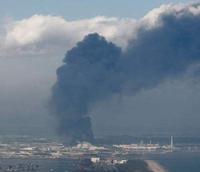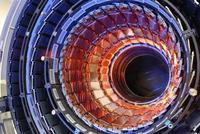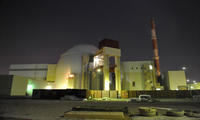-
Japan facing a nuclear catastrophe

Initial estimates say that the Magnitude 9.0 earthquake and tsunami killed about 10,000 people and made hundreds of thousands homeless; Japan is facing another threat: radioactive contamination from four damaged nuclear power plants; the tremor damaged the cooling systems in the reactors, forcing the companies operating the plants to flood the reactors with corrosive sea water and boric acid; one containment vessel was destroyed in an explosion, and in order to prevent more explosion, radioactive-contaminated hydrogen had to be released, increasing the radioactive levels to unsafe levels; more than 200,000 people living in the vicinity of the reactors were evacuated; the government has began distributing iodine pills to citizens (the pills are used to protect the thyroid gland from the effects of radiation); the difficulties at the nuclear power plants mean that rotating power outages will be imposed across Japan as of Monday
-
-
Magnetic battery to monitor buried nuke waste for 100 years
There is a new way to monitor deeply buried nuclear waste: University of Bristol researchers have developed a “battery” that uses a magnetic spring to create the necessary power to send a message from a repository to the outside world 100 years on; Doug Parr, chief scientist at Greenpeace in the United Kingdom, is unimpressed. “Spent fuel remains hazardous for 240,000 years. It’s good to see there’s a possibility of monitoring for the first 100 years — that just leaves the other 99.96% of the time to worry about”
-
-
Thorium could be answer to South Africa's energy woes

South African scientists are increasingly touting thorium as a viable solution for the country’s energy woes; scientists believe that South Africa could use its plentiful reserves of thorium, a radioactive rare earth metal, to generate greenhouse gas-free electricity; South Africa’s aging energy infrastructure has led to rolling blackouts and energy rations; South Africa currently generates 78 percent of its energy from coal making it one of the largest contributors of greenhouse gases in the world; thorium is a better alternative to uranium in nuclear power production as it cannot be weaponized, does not need to be converted or enriched, its radioactive waste breaks down faster, and is less expensive and environmentally friendlier to extract
-
-
In a setback, Iran unloads nuclear fuel from Busheher reactor

Iran announced Saturday it was unloading nuclear fuel from the Bushehr reactor, signaling more problems for the Russian-built plant after decades of delay; a source close to the project said the fuel was being unloaded on the suspicion that metal particles from nearly 30-year old equipment used in the construction of reactor core had contaminated the fuel; a senior Iranian official said earlier this month that suggestions should be investigated that the Stuxnet computer worm, believed to have been an attempt by Iran’s enemies to sabotage the nuclear program, had caused harm to the 1,000 megawatt Bushehr reactor
-
-
U.K. plans new body for the regulation of nuclear power
The United Kingdom is setting up a new nuclear regulatory body; the Office for Nuclear Regulation (ONR) would be a new independent regulator, formally responsible in law for delivering its regulatory functions and consolidating civil nuclear and radioactive transport safety and security regulation in one entity
-
-
Controversial nuclear reactor design moving toward approval
A controversial new nuclear reactor design is moving ahead for approval by the U.S. Nuclear Regulatory Commission (NRC); the chairman of the NRC announced that the agency would open the design for public comment before deciding whether to approve the reactor; critics of the proposed reactor, a Westinghouse AP1000, believe that in the event of an accident its safety measures are inadequate; if approved, the reactor could be used in as many as fourteen nuclear power plants
-
-
U.K. to impose hefty clean-up bill on nuclear power
U.K. energy and climate change minister Christopher Huhne last week made nuclear energy in the United Kingdom a whole lot less attractive; the liability for clean-up in case of a nuclear accident is currently limited to 140 million Pounds; the EU has proposed increasing this to 600 million Euros (507 million Pounds); Huhne wants to raise it to 1 billion Pounds (1.2 billion Euros).
-
-
China's nuclear power expansion is based on thorium
The thorium fuel cycles produce almost no plutonium, and fewer higher-isotope residuals; thorium is much more abundant than uranium, and the reduced plutonium output eases proliferation concerns; the energy output per ton is also attractive; China has committed itself to establishing an entirely new nuclear energy program using thorium as a fuel; six heavy-water thorium reactors are planned in India, which has the world’s largest thorium deposits
-
-
Offshore nuclear power plant safer against terrorists
Building nuclear power stations underwater could help protect them from terrorist attacks, according to a French company hoping to do just that; the plant would sit on the seafloor at a depth of 60 meters to 100 meters, a few kilometers off shore; the design would make the plant resistant to tsunamis, earthquakes, or floods, and its underwater position makes it less vulnerable to terrorist attacks
-
-
Nuclear experts downplay China nuclear 'breakthrough'
Earlier this month, the China National Nuclear Corporation said it had achieved a significant “breakthrough” by developing a fuel reprocessing technology that will extend the lifespan of Beijing’s proven uranium deposits to 3,000 years, from the current forecast of 50-70 years; nuclear experts say, however, that other countries already own such technology — and that the real question is whether China will reprocess spent fuel on an industrial scale
-
-
Cement prison for old radioactive waste
The cold war may be over, but its radioactive legacy is not; between 1950 and 1990, nuclear weapons materials production and processing at several federal facilities generated billions of gallons of water contaminated with radioactive byproducts; researchers at Idaho National Laboratory test an inexpensive method to sequester strontium-90 where it lies. The researchers can coax underground microbes to form calcite, a white mineral form of calcium carbonate and the main ingredient in cement. Calcite should be able to trap strontium-90 until long after it has decayed into harmless zirconium
-
-
New technology speeds cleanup of nuclear contaminated sites
Hundreds of millions of dollars are spent on cleanup of some major sites contaminated by radioactivity, primarily from the historic production of nuclear weapons during and after the Second World War; Oregon State University researchers have invented a new type of radiation detection and measurement device that will be particularly useful for cleanup of sites with radioactive contamination, making the process faster, more accurate and less expensive
-
-
China says it has mastered the process of reprocessing nuclear fuel
One way to extend to energy productivity of nuclear fuel is to reprocess it after it has been used; reprocessing nuclear fuel costs significantly more than using it once and storing it as waste; it is also controversial because extracted plutonium can be used in nuclear weapons; China has just announced that it has mastered the technology for reprocessing fuel from nuclear power plants, potentially boosting the supplies of carbon-free electricity to keep the country’s economy booming
-
-
WikiLeaks: Yemen radioactive stocks "easy al-Qaeda target"

Yemeni official told U.S. diplomats that the lone sentry standing watch at Yemen’s national atomic energy commission (NAEC) storage facility had been removed from his post, and that the facility’s only closed circuit TV security camera had broken down six months previously and was never fixed; “Very little now stands between the bad guys and Yemen’s nuclear material,” the official warned, in a cable dated 9 January this year sent from the Sana’a embassy to the CIA, the FBI, and the department of homeland security; when told of the Yemeni nuclear storage problem, Matthew Bunn, a Harvard University nuclear terrorism expert, said: “Holy cow. That’s a big source. If dispersed by terrorists it could make a very nasty dirty bomb capable of contaminating a wide area”
-
-
Debate over extending operation of aging NY reactor
The Indian Point Energy Center is located on the banks of the Hudson River just twenty-four miles north of Manhattan; its reactors are aging: the first reactor at the center began operating in 1962 and shut down in 1974; two new reactors were built in 1974 and 1976; the plant operator seeks permission from the U.S. government to extend operations at the plant; many locals oppose the extension, citing what they say are inadequate emergency evacuation plans in the event of a disaster, and the damage the plant cooling system inflicts on aquatic life
-
- All
- Regional
- Water
- Biometrics
- Borders/Immig
- Business
- Cybersecurity
- Detection
- Disasters
- Government
- Infrastructure
- International
- Public health
- Public Safety
- Communication interoperabillity
- Emergency services
- Emergency medical services
- Fire
- First response
- IEDs
- Law Enforcement
- Law Enforcement Technology
- Military technology
- Nonlethal weapons
- Nuclear weapons
- Personal protection equipment
- Police
- Notification /alert systems
- Situational awareness
- Weapons systems
- Sci-Tech
- Sector Reports
- Surveillance
- Transportation
Advertising & Marketing: advertise@newswirepubs.com
Editorial: editor@newswirepubs.com
General: info@newswirepubs.com
2010-2011 © News Wire Publications, LLC News Wire Publications, LLC
220 Old Country Road | Suite 200 | Mineola | New York | 11501
Permissions and Policies
Editorial: editor@newswirepubs.com
General: info@newswirepubs.com
2010-2011 © News Wire Publications, LLC News Wire Publications, LLC
220 Old Country Road | Suite 200 | Mineola | New York | 11501
Permissions and Policies
